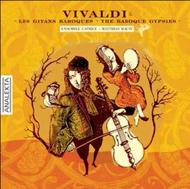
Vivaldi and the baroque gypsies
£14.49
Usually available for despatch within 3-5 working days
Despatch Information
This despatch estimate is based on information from both our own stock and the UK supplier's stock.
If ordering multiple items, we will aim to send everything together so the longest despatch estimate will apply to the complete order.
If you would rather receive certain items more quickly, please place them on a separate order.
If any unexpected delays occur, we will keep you informed of progress via email and not allow other items on the order to be held up.
If you would prefer to receive everything together regardless of any delay, please let us know via email.
Pre-orders will be despatched as close as possible to the release date.
Label: Analekta
Cat No: AN29912
Format: CD
Number of Discs: 1
Release Date: 15th October 2007
Contents
Works
Collection Uhrovska, 1730Concerto for 2 flutes in C major, RV533
Concerto in B flat major for recorder, strings and basso continuo, RV375
Concerto in C major, RV87
Flute Concerto in G minor, RV104 'La notte'
Artists
Matthias Maute (recorder)Ensemble Caprice
Works
Collection Uhrovska, 1730Concerto for 2 flutes in C major, RV533
Concerto in B flat major for recorder, strings and basso continuo, RV375
Concerto in C major, RV87
Flute Concerto in G minor, RV104 'La notte'
Artists
Matthias Maute (recorder)Ensemble Caprice
About
As a virtuoso and composer, Vivaldi travelled widely. He is known to have attended performances of his operas in Prague and also in Vienna which took him close to the Balkans, and it is likely that he encountered nomadic musicians during these excursions. In fact, this was nothing unusual because Georg Philipp Telemann, who worked for a time in Poland, commented that a skilled composer could gain enough musical inspiration to last a lifetime by listening to gypsy musicians.
Vivaldi taught for many years at the orphanage school famous for its shining musical life: the Ospedale della Pietà. This “orphanage” (in fact a home for the illegitimate daughters of noblemen) lay on the Riva degli Schiavi, the Slavic Canal. One can easily imagine how travellers arriving from Eastern European countries would perform their music with their instruments and songs, practically on Vivaldi’s doorstep!
The obvious closeness to gypsy music of the motifs used in the opening tutti in the third movement of the late concerto RV 375 makes it even more tempting to surmise that Vivaldi must have come into contact with music from Eastern Europe. The ragged initial sixteenth notes, the syncopated rhythms, the abrupt dynamic contrasts and the pianissimo passages that appear are almost identical in the collection of gypsy music Uhrovska (1730) and are strong evidence to support the claim in the New Grove Dictionary of Music and Musicians that Vivaldi was inspired by the music of the Slavic hinterlands.
The Uhrovska collection (named for the eponymous town in present-day Slovakia where it was found) is a fascinating document that provides a direct glimpse into the world of gypsy music. The approximately 350 melodies it contains were probably intended to be as comprehensive a collection of gypsy music as possible. Its multi-national character documents the extent to which the gypsies—and their music with them —travelled. Hungarian melodies stand next to Czech songs and the location of Uhrovska’s discovery in Slovakia suggests further national influences.
Contrary to the oral tradition of the gypsies, in essence without written record, a travelling master violinist must have attempted to assemble the music of his people into a comprehensive “catalogue”. Few gypsies would have studied notation and so we must infer that Uhrovska was compiled by a travelling musician who had come into contact with the educated classes of his time. In this case, he utilized a sort of shorthand, leaving plenty of room for creativity.
Apart from a few exceptions, the music in the Uhrovska collection is notated in a single voice and so the bass line and the harmonic and rhythmic fleshing out in the mid-range would have been improvised. Thus, it was implied that the pieces would be arranged ad hoc by gypsy bands. We have adopted this practice and expanded the melodies into multi-voiced pieces.
Error on this page? Let us know here
Need more information on this product? Click here